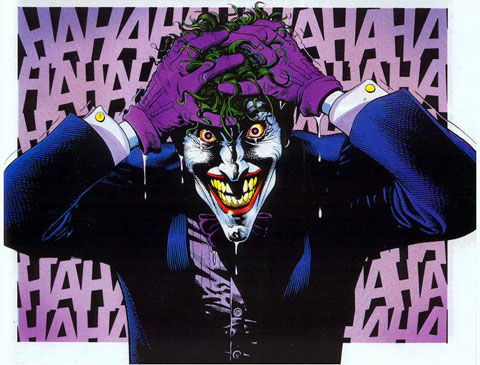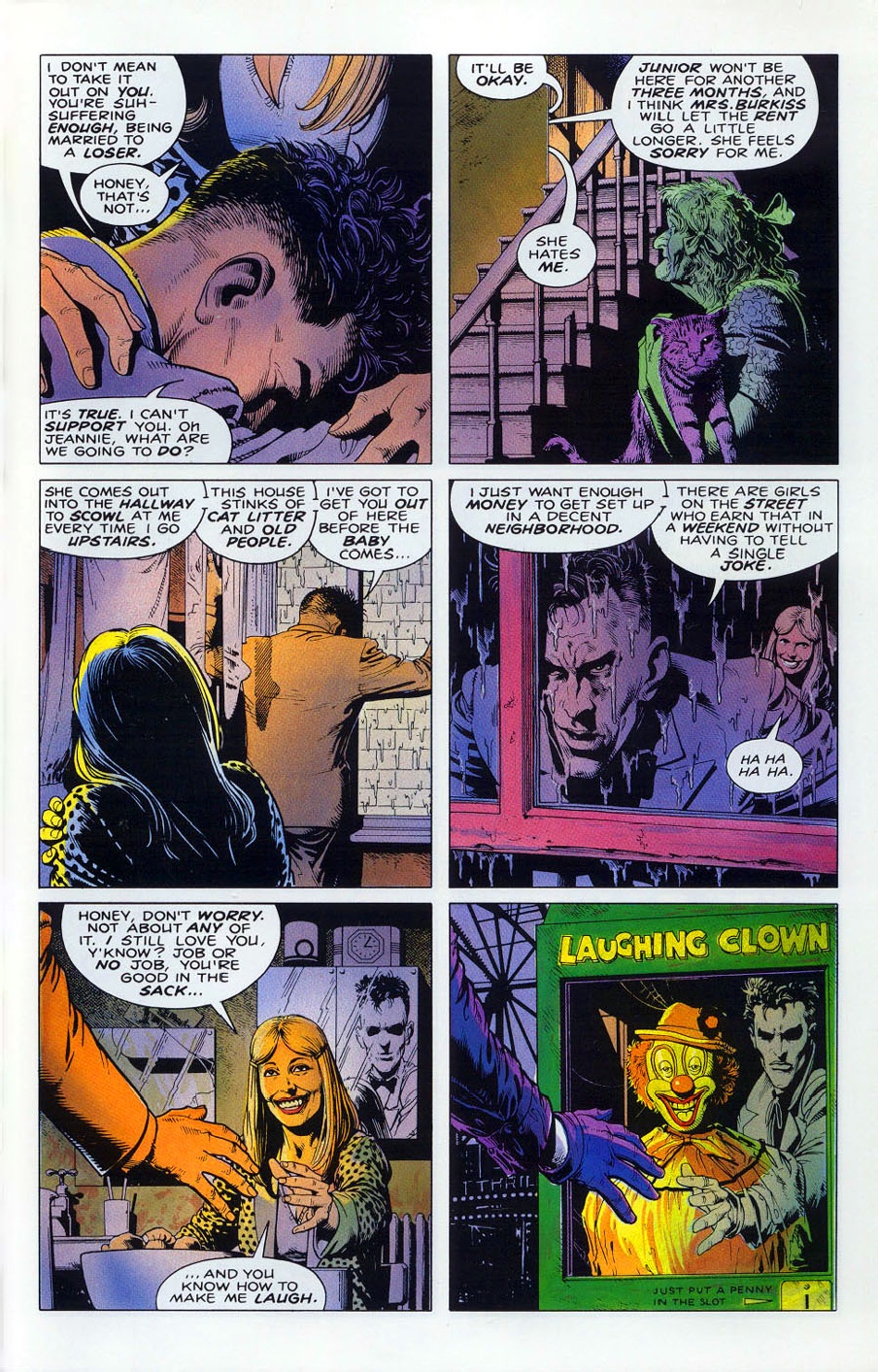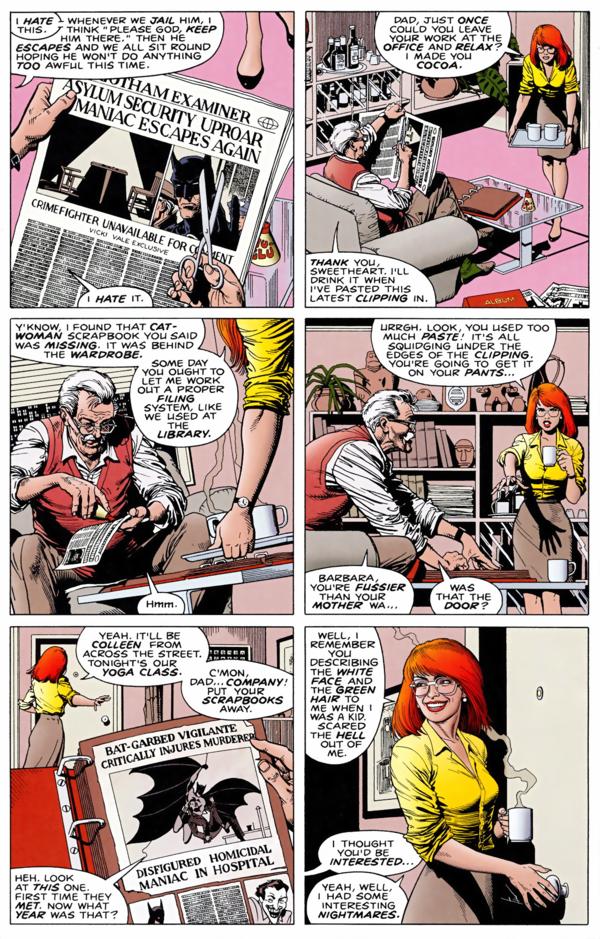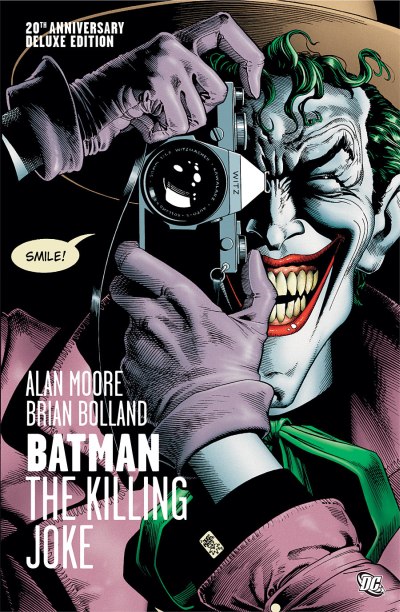Prompted by Osvaldo Oyola’s essay earlier this week, I moved about six boxes of clothes and a paper cutter out of the closet in order to get at my comics collection and reread Alan Moore and Brian Bolland’s The Killing Joke.
And no, it wasn’t really worth it. The comic was a disappointment when I first read it upon its release in 1988, and 25 years later it continues to underwhelm. The Joker’s sad sack origin hasn’t gotten any less pro forma melodrama with the passage of time, while the visual rhymes and formal density that served Moore so well in Watchmen here simply inflate a standard genre exercise in good guy/bad guy pulp doppelganger Manicheanism with gratuitous pomposity, robbing it of charm without adding any weight. The sexualized crippling/rape of Barbara Gordon is, as Osvaldo says, a low point, but it’s also of a piece. Extra violence, extra sex, extra unpleasantness, extra formal trickery and the odd leaden bit of wordplay; it’s all there to desperately claim significance via special pleading, rather than by actually writing a thoughtful story. Bang, Pow, Batgirl shot through the spine, comics not just, etc.
There was one pleasant surprise, though; Brian Bolland’s art. I’d always thought of him and Watchmen artist Dave Gibbons as more or less interchangeable, but in fact Bolland’s work is a lot more fun to look at. His faces have a nice plasticity and solidity; a realism shading into cartoonish grotesque which fits the Joker nicely — and suggests the throwaway EC comics horror dreck hiding beneath Moore’s high-falutin’ script. In some sense, it makes you wonder whether the problem with The Killing Joke is that Bolland is too good, his enthusiastic mastery pulling Moore by the collar into a farrago of pulp, just like those grossly offensive dwarves pull Gordon onto the train to view a cornucopia of sadistic incest torture porn. Much of Moore’s career has been a sometimes winning, sometimes losing struggle with genre, and in this case genre appears to have teamed up with Bolland to strip him naked and kick his sorry ass. Then he rose up with his hands on his head, giggling maniacally and burbling about how cool it would be to have Boland draw circus freaks and sexual assault — all for profound philosophical reasons, of course.
Be that as it may, Boland adds significantly to the weirdest, most disturbing moment of the comic.
That’s the Joker in his sad sack pre-Joker days, talking to his pregnant wife about how he’s once again failed to get a gig as a comedian. He makes some bitter, crude remark about how girls on the street can make more money than him — and his loving, long-suffering, nurturing wife cracks up. She finds bitter allusions to prostitutes funny, and tells him he’s good in the sack as she reaches for him with a bizarrely exaggerated clown grin.
On the one hand, the grin is there to supply the transition to the laughing clown in the next panel. But it also makes the wife the ur-Joker — the one who finds (her husband’s) suffering and (female) degradation funny, and the one with the demon’s grin. Boland really sells that too; I didn’t remember the dialogue here at all, but that feral, toothy, malevolent smile stayed with me across the decades. Pre-Joker’s hollow, confused look in the mirror is also perfect — he doesn’t look like a man being comforted by his wife. He looks like the terrified victim who suddenly realizes the evil spirit has possessed his love one, and is about to devour him. Osvaldo notes Joker’s queerness — I think that queerness is here presented, specifically, as transvestism. The Joker is taking the place of his wife, or his wife (who we later learn dies in a freak accident) is possessing him.
That sequence seems like a tell; a quick conflation of sex, femininity and terror which suggests that the assault on Barbara Gordon isn’t an accidental, unnecessary indiscretion, but rather a condensation of the book’s central obsessions. In the panel before she’s shot, Barbara too wears that weird Joker grin, her hand extended as Joker’s wife’s hand was extended, the coffee-cup echoing the pencil cup in the other image. Thus Joker is both his wife and the murderer of his wife; the sexualized, uncanny woman brings upon herself vengeance for her wrongness. As in Junji Ito’s Tomie stories, the female ensorcels men, and what she ensorcels them to do is murder her.
Ito’s stories present his horror and lust — or his horror of lust, or his lust for horror — without apology. Not so Moore, who wants us to believe that he didn’t really want to show us those pictures of Barbara Gordon, or that he doesn’t really enjoy all those gruesome rictus grins on the corpses, or that he didn’t really want to off the Joker’s wife. Moore’s rooting for sanity and Gordon and Batman and reconciliation and rehabilitation along with the rest of us, right? The real killing joke, maybe, is that it doesn’t matter whether Batman kills the Joker, or Batman kisses the Joker. The structure and the end aren’t important. Instead, what matters here are those women grinning and asking for sex and death, the genre pleasures that make us smile.




On that scene with the wife- you know I don’t think any of the dialogue in that scene suggests that she is possessed by the Joker. She just comes off as a supportive, nurturing idealized wife who unconditionally loves her loser husband.
I just checked the script and any suggestion that she’s the Ur-Joker is not Moore’s but Bolland’s. Moore just says she’s happy and she smiles, and that there’s a hint of sex in the air in the way she looks at him. Bolland also deviates from the script in the last panel, which calls for a hideous “laughing sailor” not a laughing clown.
It’s definitely suggested by the art mostly…though the dialogue is odd. Laughing spontaneously at that utterly unfunny reference to prostitution kind of comes out of nowhere, as does the earthy sexual reference. It’s interesting that Bolland is the one who pushes it to be actual horror-filmesque, though.
The fact that she’s the ur-Joker is the most interesting thing in the comic, I’d say. So kudos to Bolland.
Well Joker is never funny, right? But she has a unique sense of humor so finds him funny.
It’s left open for interpretation but I guess the joke for her as Moore intended it could be “Being a comedian – that’s rough. If only I could get a decent, honest job like prostitution.”
“I’d always thought of him and Watchmen artist Dave Gibbons as more or less interchangeable…”
For shame!
Also, one should not put too much store in Moore’s script. We have no idea how Moore worked with Bolland over the many months the project took to complete. But if it’s anything like Watchmen, they would have had lots of off script discussions. Having said that, Bolland is probably a more interesting comics writer than Gibbons so I wouldn’t be surprised if the idea(s) was his.
Yeah. It sort of fits with my fanciful idea that Bolland is the one pushing for the balls-out, honest exploitation, with Moore cheering on and then sort of guiltily trying to pretend that there’s something “deeper” going on.
It’d probably be completely forgotten if it were just honest exploitation crap. But it’d be a better comic.
A work of “genius” compared to Gaiman’s Last Batman Story though – a nostalgic and utterly banal attempt at depth
Haven’t read that one thankfully!
As an Alan Moore fanatic when it first came out, TKJ was, in retrospect, my first indication that not everything he touched was golden and I agree completely that Bolland seems like the real winner. Even at the time it seems like he did more covers than full stories; Camelot 3000 was several years in the past by then, so it was nice to see him strut his stuff for a full-lengther again. BTW, isn’t there a theory that the Joker is the ultimate unreliable narrator of DC and that all of his origin stories should be taken with a grain of salt, even within continuity? Did that concept originate in TKJ or elsewhere?
Moore’s other take on Batman at the time was his Clayface story that ran in Batman Annual #11 drawn by George Freeman. As I recall, it wasn’t even treated as that big of a deal but it was really quite good, certainly better than TKJ! Narrated by Clayface, it presented his delusional narration of events contrasted with depressing reality as revealed in the accompanying drawings and concerned his falling in love with a department store mannequin that he believes to be a real woman. I think it’s been reprinted, and it’s definitely worth a read.
If anything, you’ve just reinforced for me why my more recent readings of the Killing Joke led to my appreciating it a lot more than I did when I first read it, or even read it again 10 years later (now 15 years ago).
I think the Joker’s “pro forma sad sack origin” is very much to the point. It explicitly unreliable – one of many possible origins, but the most banal and melodramatic, outlining form and structure as a way to highlight its problems.
I think that prostitution “joke” is funny, too – not because I like degrading women (though I refuse to believe all sex work is necessarily degrading), but because of the irony in the pre-Joker’s self-centeredness and agony over trying to be seen as funny. “Nothing is worse than having to tell jokes for a living” is an absurd sentiment – laughable.
I do agree that Bolland’s art does a lot of heavy lifting here, but maybe it is just that I like problem texts – like Shakespeare’s “Measure for Measure,” but I also kind of love “EC comics horror dreck,” thus my appreciation.
Anyway, I do like the idea of the Joker dressed up as his own wife, that at some level she does not exist. I’ll have to think about that some more, but I think it can work with my reading.
I did nearly write about that panel with the Joker reaching out to his reflection in the glass of the animatronic clown thing. It is another silent contemplative panel with an echo to his wife, but including a reflection of himself. Yes, it totally works.
P.S. You spelled my last name wrong in the first sentence of this piece.
Ah, crap. Sorry about that; I will fix. (My spelling always sucks.)
I don’t think sex work is necessarily degrading…but the Joker appears to think it is, and KJ is pretty explicit about presenting female sexualization as degrading.
I think you could definitely work the ambivalence about femininity in the book into your discussion of the ambivalence about queerness.
My take on Mrs Joker’s laughter is that she’s trying, not very convincingly, to reassure her husband that he’s still funny. Her smile looks very fake to me, not like Barbara Gordon’s which looks quite natural.
I haven’t read the book since it came out, and I never really thought about the cover. But reading this essay made me aware that it’s the post rape scene that we don’t “see” in the book, with the reader in the Barbara Gordon position. This put me in mind of Sontag’s book “On Photography,” in which she characterizes photography as a means to possession, and as a symbolic rape or murder. That is, photographs encourage the viewer to code the subject of the photograph as an object. She was also seriously pessimistic about photography’s capacity to raise concern or social awareness. She even goes as far as to argue that this sort of photography deadens our consciousness at least as much as it arouses it. Now, I’m not agreeing with Sontag on these points (even later Sontag doesn’t agree with Sontag on these points), but I’m pretty sure Moore was riffing on her. To my eye the tell is in the rape sequence itself, when the Joker shows up looking like a tourist, as Sontag makes a point to argue that taking photographs on vacation is a particularly pernicious expression of the technology’s role as a servant to capital; taking pictures while abroad is way to prove of consumption to friends and neighbors. Without the issue in front of me, I can’t say for sure how photography plays out in the course of the larger narrative, but I’m thinking that between the Sontag allusions and the cover he’s trying (key word, trying) to implicate the reader in his depictions of violence.
Well, the cover seems pretty clearly to be trying to do the “implicate the viewer” thing. As I said, I think the book in general ends up being fairly sanctimonious.
I think “sanctimonious” is just about the last word I’d use for The Killing Joke. You think it makes a show of being morally superior to other people? I don’t see it.
Yeah, I kind of do. It’s pretending that it’s horrified at what the Joker is doing, right? He’s bad, bad, bad for shooting Gordon and showing those pictures. But it revels in those pictures at the same time.
It is doing the Paul Verhoeven thing to some extent, where it’s condemning the pulp nastiness while revelling in it. It’s not as clever about it as he is though (and I don’t think it works especially well for him most of the time.)
That’s why I say I think I’d like it better if it were like Ito and just embraced its anxiety and nastiness without trying to turn it into a moral parable. It seems more honest.
Now that you’ve mentioned it, i can’t stop looking at her smile — creepy. It looks too big for her face
I was given an early pre-publication copy in 1987-88 when I was in England by my friend Ed Brennan who interviewed Moore for Something Strange magazine, but sadly, I was horrified and disappointed. The story is awful. It compares badly with Watchmen. Bolland is able to do some effective cover drawings, but he is not so much of a cartoonist as Gibbons…and, Moore gave him considerable less to work with. As a whole, it kind of sits there, dead on the page, when it isn’t either silly or vilely exploitative. The digital color shown in the example above is if anything, even worse than that of the original version. Yuck.
Huh…so you like Gibbons more than Bolland? Someone else just said the same over on Facebook. I don’t see it myself. Why do you find Gibbons superior?
“my fanciful idea that Bolland is the one pushing for the balls-out, honest exploitation, with Moore cheering on and then sort of guiltily trying to pretend that there’s something “deeper” going on”
Against this, there’s the fact that Bolland recoloured the book in 2008 with a more subdued and somber — and putatively, thereby more serious — palette. And, contra James, aren’t those actually the original colours up there?
The scans are pulled from the web, so there could be some with the original and some recolored. I hadn’t realized there had been a recoloring, actually.
Oh, I think it was new but it could be the old ones. Whatever, I don’t like them, although the same colorist did okay on Watchmen. Gibbons is a cartoonist. He did a good job on Watchmen. I haven’t seen a comic by Bolland that I liked, although he does nicely on covers
Judge Dredd? Mr Mamoulian? Actress and the Bishop? He’s probably *the* Judge Dredd artist even though he didn’t originate the character.
There’s also this story he did for Strange Adventures called The Kapas. (http://grantbridgestreet.blogspot.sg/2011/05/kapas-by-brian-bolland.html) I can’t tell if this one is based on historical fact, vaguely racist, or has some finer point which I’m missing. There’s obviously some anti-colonial guilt in there of course but what else?
That art’s the original, the recolored has more of a noir look with less bright colors.
In Artists on Comic Art Bolland talks about doing a signing with Moore after the Killing Joke Came Out, he says “When I met him after it was over and we were doing these book signings, I remember him saying that, to him, it was just another Bat comic, which kind of hurt my feelings. For me it was this grand thing I had been building up to and I wanted it to be really special.”
He also says “To me, Judge Death was almost a dry run for drawing the Joker, with that kind of fixed, rictus grin on his face. It was almost an obsession I had with the Joker.”
Make of that what you will…
hmmm…I think maybe the first two excerpts are original, and the second two are recoloured? Don’t have my copy at hand, but that’s my impression from a quick search on google.
For the record, I prefer the re-coloring. . .
Jones- I think you are correct.
Yeah, sorry, I guess I am unclear. Bolland is certainly an accomplished artist. I recall a run of covers he did for Animal Man for Vertigo, for instance, each one inventive, extremely meticulous and beautifully colored (his own color is leagues away from what we see above). But I don’t really see him as being as effective in the role of a narrative cartoonist and so I didn’t so much appreciate what he did in the Vertigo anthologies and that Camelot miniseries years ago. Judge Dredd leaves me absolutely cold.
I think John Higgins’ coloring was an incredible compliment to Bolland’s art. The saturated colors and broad palette contrasted with the imagery, as if the clownish chaos of The Joker was seeping into every pore in every panel. I thought Bolland’s recoloring was really bland and took away a lot of the tension. It would have been better in black and white.
Some points touched on…
1) The Joker as an ‘unreliable narrator’ on his origin is not from the comics, but from Christopher Nolan’s ‘The Dark Knight’ movie.
In comics, the Joker’s origin was set out, oddly enough, in a Robin short featuring the Red Hood identity; Moore expanded on this.
2) The prostitution “joke” — Noah, it’s not presented as a joke, but as a grim, simple statement of fact.
The wife laughs, in effect, to cheer up the man she loves, to get him to lighten up, to reassure him that she still loves him and believes in him desdpite everything. This adds to the tragedy of her senseless death.
3) Interesting that, instead of a clown automaton, Moore’s script had called for a laughing sailor automaton.
Have you seen either the play or film ‘Sleuth’ by Schaffer (with Laurence Olivier and Michael Caine in the flick)? I had the fortune, back in 1969, to see the original London run…A key prop was a laughing ‘Jolly Jack Tar’ sailor automaton.
I’m sure this was Moore’s inspiration!
Alex, re: 2 — that’s a plausible interpretation. However, I think that leering smile that Bolland gives her pushes it towards a less benign interpretation.
Which is arguably again the most interesting thing in the book. It allows her to be weird and sexually aggressive and callous, rather than just a bog standard supportive wife and victim. She’s a much more interesting character if she thinks it’s actually funny,and if she’s partially laughing at him rather than just for him.
I remember the original Red Hood origin story, but I don’t think it was a Robin solo thing:
http://en.wikipedia.org/wiki/The_Man_Behind_the_Red_Hood!
(BTW, I remember one interesting thing about the original Red Hood story was that it involved Batman and Robin teaching a criminology course at Gotham University (!) and that one of the students was an asian guy, presented in a non-stereotypical, non-offensive way. One of the first such appearances in mainstream comics?)
As for the laughing sailor, I think you’re probably right about the Sleuth angle. And on that note, check out this nightmare-inducing clip:
http://www.youtube.com/watch?v=7eN3fxzn0ro
Of course the whole “dark carnival”/sinister automaton thing recalls Ray Bradbury as well.
I think Tod Browning is probably a reference point as well.
Lon Chaney:
“There is nothing funny about a clown by moonlight.”
Here’s a page with some examples of the original colors versus the recolored version: http://jimsmash.blogspot.com/2008/03/batman-killing-joke-re-colored.html. If you ask me, the new version is kind of awful, turning the lurid nightmare of the original into the bland, standard look of 21st century comics’ computery shininess.
I wasn’t aware that Bolland did the recoloring—-guess I haven’t looked at the new version at all! I first read it in B&W and didn’t like it then. While I somehow got a copy of the first edition, I didn’t keep it, so I have nothing to compare. But nothing changes that the worst thing about it is the story, such as it is. I mean, it’s obvious that Bolland worked hard on his art…poor sod.
AB- you’re wrong about Joker not being an unreliable narrator in the Killing Joke. Joker says
“”Something like that happened to me you know. I… I’m not exactly sure what it was. Sometimes I remember it one way, sometimes another… If I’m going to have a past, I prefer it to be multiple choice! HA HA HA!”
Nolan probably got it from Moore.
Thanks for the confirmation pallas. I hadn’t actually pulled out my copy of TKJ until last night, but you’re right about the dialogue confirming the unreliable narrator thing. I suppose this was Moore’s way of acknowledging that this version of the origin was at odds with the earlier one, though it retains the idea of the Red Hood as an identity assumed by multiple people. A nice touch, actually.
Are there any examples of recolouring that has improved the original?
I’m probably in the minority, but I like the coloring on the Marvel Masterworks much better than the originals.
Following this debate really took me back again into the late 80s when all these ambitious attempts to reinvent Batman came out following The Dark Knight Returns. You could even be lead to believe computer enhanced drawings might actually have been a good idea then — if you look at a book like Digital Justice. I think it’s comparable to TKJ in the way the artwork and atmosphere are very unique, while the story certainly is a bit shallow and pretentious. I’d love to read such inspired criticism of Digital Justice, but I’m not sure if the subtext actually would be as rich. It seemed more like a feelgood kind of book, not as dark as Moore’s writing … the idea to put Batman into a cyberpunk future wasn’t all that bad though.
Pingback: Batman: The Killing Joke shows why you can't just 'update' sexist source material - ITS RELEASE
Pingback: Batman: The Killing Joke and why you can't just 'update' sexist source material
Pingback: Batman: The Killing Joke and why you can’t just ‘update’ sexist source material – PodCastSurvey
Pingback: Batman: The Killing Joke and why you can’t just ‘update’ sexist source material | Ep4records Music
Pingback: Batman: The Killing Joke and why you can’t just ‘update’ sexist source material | BuzzWare